|
|
 |
John Wootton
|
|
1682 - 1764
English painter. He probably received some instruction from Jan Wyck in the 1690s, and he was possibly patronized from an early age by the aristocratic households of Beaufort and Coventry (as was Wyck), perhaps while working as a page to Lady Anne Somerset at Snitterfield House, Warwicks. However, there seems to be no real evidence for this save his early painted view of the house and the family's later acquisition of many of his works. Joseph Farington saw a painting of Diana and the Nymphs (1707; untraced) at Antony House, Cornwall, but Wootton's earliest extant dated work is the horse portrait Bonny Black (1711; Belvoir Castle, Leics). By this time he had begun to establish himself in London, having moved there before his first marriage, to Elizabeth Walsh, in 1706. |
|
|
|
|
|
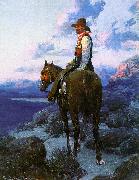 |
Johnson, Frank Tenney
|
|
American Painter, 1874-1939
was a painter of the american west, and he popularized a style of painting cowboys which became known as "The Johnson Moonlight Technique". Somewhere on the Range is an example of Johnson's moonlight technique. To paint his paintings he used knives, fingers and brushes. Johnson was born in Pottawattamie County, Iowa, on his family's farm along the old Overland Trail near a town then called Big Grove and now known as Oakland. Johnson's mother died in December 1886, and by 1888 the family had moved to Milwaukee. There, in 1893, he enrolled in the Milwaukee School of Art (absorbed by Milwaukee State Normal School in 1913), where he studied with a well-known painter of western subjects, Richard Lorenz. |
|
|
|
|
|
 |
Jonas Lie
|
|
Jonas Lauritz Idemil Lie (6 November 1833 - 5 June 1908) was a Norwegian novelist, poet, and playwright who is considered to have been one of the Four Greats of 19th century Norwegian literature, together with Henrik Ibsen, Bjornstjerne Bjørnson and Alexander Kielland. |
|
 |
Jonathan Eastman Johnson
|
|
1824-1906
Jonathan Eastman Johnson Galleries
Eastman Johnson (July 29, 1824 - April 5, 1906) was an American painter, and Co-Founder of the Metropolitan Museum of Art, New York City, with his name inscribed at its entrance. Best known for his genre paintings, paintings of scenes from everyday life, and his portraits both of everyday people, he also painted portraits of prominent Americans such as Abraham Lincoln, Nathaniel Hawthorne, Ralph Waldo Emerson, and Henry Wadsworth Longfellow. His later works often show the influence of the 17th century Dutch masters whom he studied while living in The Hague, and he was even known as The American Rembrandt in his day.
Johnson's style is largely realistic in both subject matter and in execution. His original photorealistic charcoal sketches were not strongly influenced by period artists, but are informed more by his lithography training. Later works show influence by the 17th century Dutch and Flemish masters, and also by Jean François Millet. Echoes of Millet's The Gleaners can be seen in Johnson's The Cranberry Harvest, Island of Nantucket although the emotional tone of the work is far different.
His careful portrayal of individuals rather than stereotypes enhances the realism of his paintings. Ojibwe artist Carl Gawboy notes that the faces in the 1857 portraits of Ojibwe people by Johnson are recognizable in people in the Ojibwe community today. Some of his paintings such as Ojibwe Wigwam at Grand Portage display near photorealism long before the photorealism movement but in keeping with the American tradition of realism that can be seen in the works of Charles Willson Peale whose painting The Stairway Group is said to have fooled George Washington.
His careful attention to light sources contributes to the realism. Portraits Girl and Pets and The Boy Lincoln make use of single light sources in a manner that echoes the 17th Century Dutch Masters. |
|
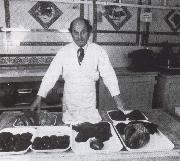 |
jonathan miller
|
|
(born July 21, 1934, London, Eng.) British director, writer, and actor. After earning a medical degree at Cambridge University, he made his professional stage debut at the Edinburgh Festival in the hit satirical revue Beyond the Fringe (1960). |
|
|
|
|
|
|
|
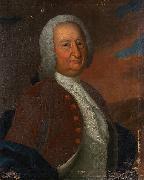 |
Jons Pilo
|
|
Jöns Pilo (1707-1750)Aliases: Jons O. Pijhlou; Jons O. Pijlou; Jons O. PiloProfessions: Painter
|
|
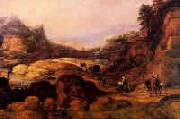 |
Joos de Momper
|
|
Flemish Baroque Era Painter, 1564-1635
known as Josse de Momper, is one of the most important Flemish landscape painters between Pieter Brueghel the Elder and Peter Paul Rubens. Brueghel's influence is clearly evident in this many of de Momper's paintings.
Born in 1564 in Antwerp, Joos de Momper was first apprenticed to his father. In the 1580s, he travelled to Italy to study art. De Momper primarily painted landscapes, the genre for which he was well-regarded during his lifetime. He painted both fantasy landscapes, viewed from a high vantage point and employing a conventional Mannerist color transition of brown in the foreground to blue and finally green in the background, and more realistic landscapes with a lower viewpoint and more natural colors. His wide panoramas also feature groups of figures. Only a small number of the 500 paintings attributed to De Momper are signed, and just one is dated. |
|
|
|
|
|
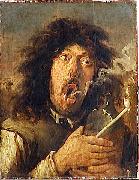 |
Joos van Craesbeeck
|
|
(c. 1605/06- c. 1660) was a Flemish painter who specialized in tavern interiors, tronies, and other works similar to his teacher Adriaen Brouwer. Born in Neerlinter (Flemish Brabant), he became a master in Antwerp's guild of St. Luke in 1633?C1634, and like his contemporaries David Teniers the Elder and David Rijckaert III he developed rustic genre scenes. He subsequently moved to Brussels, where he joined that city's painters' guild in 1651.
Paintings such as Death is Violent and Fast are typical of his small, theatrical images of peasants brawling crowded with violent expressive figures. Unlike Teniers, whose style became more elegant, Craesbeeck continued to paint bawdy figures later in his career.
|
|
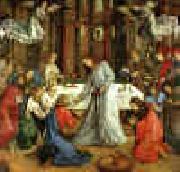 |
Joos van Ghent
|
|
Netherlandish Northern Renaissance Painter, active ca.1460-1480 |
|
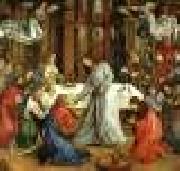 |
JOOS van Wassenhove
|
|
Dutch painter (active c.1460-80).
South Netherlandish painter, active also in Italy. First documented in 1460, when he matriculated in the Antwerp painters' guild, he subsequently moved to Ghent, entering the painters' guild on 6 October 1464. In 1467 he painted 40 escutcheons with the papal arms for the cathedral of St Bavo, Ghent, his only documented commission in the Netherlands. He sponsored the entry of Hugo van der Goes to the Ghent guild on 5 May 1467 and of Sanders Bening on 19 January 1469, the last date on which Joos is recorded at Ghent. He is stated, in a document of 1475, to have departed for Rome some time previously, with an advance of money from Hugo van der Goes. It is not known if Joos reached Rome, but it is generally accepted that he worked at Urbino, where early sources mention a Netherlandish painter, Giusto da Guanto (Justus of Ghent), who was responsible for the altarpiece of the Communion of the Apostles (Urbino, Pal. Ducale) of 1473-4. |
|
 |
Joos van Winghe
|
|
(1544, Brussels - 1603, Frankfurt), was a Flemish Renaissance painter.
According to Karel van Mander he was born in Brussels in 1544 and travelled to Rome where he lived with a Cardinal for four years. When he returned to Brussels he became court painter to the Prince of Parma until he left the country in 1584 as a consequence of the Fall of Antwerp. He settled in Frankfurt and his place at Parma's court was taken by Otto van Veen. He died in 1603, aged 61. Van Mander mentions several pieces by his hand in Brussels, Frankfurt, and Amsterdam.
According to the RKD who spent four years travelling in Rome, Parma, and Paris before returning to Brussels in 1568. In 1585 he moved to Frankfurt, where he became a citizen (burgher) in 1588 and stayed. He was the father of the painter Jeremias van Winghe, and is known for portraits and genre works, as well as book title pages. |
|
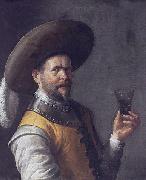 |
Joost Cornelisz Droochsloot
|
|
(1586, Utrecht (city) - May 14, 1666, Utrecht (city)), was a Dutch Golden Age painter.
According to Houbraken his village scenes (Boerekermisstuk) were as popular as flower pieces by Bartholomeus Assteyn.Houbraken thought he was born in Gorinchem or Dordrecht, and claimed he worked for a long time in Dordrecht. He felt his work was always according to a set pattern, where cake sellers were portrayed in front of village houses with figures in a festive setting called a "farmer's circus". It is unclear why Houbraken would have thought he was from Dordrecht, especially since Houbraken's data on painters from Dordrecht was generally quite accurate. Droochsloot and his son were highly respected citizens of Utrecht with a large workshop.
According to the RKD his monogram was "JCODS" and he became a member of the Utrecht Guild of Saint Luke in 1616. He later became deacon of the guild in 1623 and regent of the St. Jobs Gasthuis in 1638, deacon of the Dutch Reformed church, and in 1665 officer of the Utrecht schutterij. He was the father of the painter Cornelis Droochsloot (1630-1673) whose paintings are hard to distinguish from his own, and the teacher of Jacob Duck. |
|
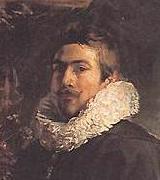 |
JORDAENS, Jacob
|
|
Flemish painter (b. 1593, Antwerpen, d. 1678, Antwerpen).
Flemish painter, tapestry designer and draughtsman. In the context of 17th-century Flemish art, he emerges as a somewhat complicated figure. His oeuvre, the fruit of a continual artistic development, is characterized by great stylistic versatility, to which the length of his career contributed. His religious, mythological and historical representations evolved from the rhetorical prolixity of the Baroque into a vernacular, sometimes almost caricatural, formal idiom. The lack of idealistic treatment in his work is undoubtedly the factor that most removed Jordaens's art from that of his great Flemish contemporaries Rubens and van Dyck. Jordaens's officially commissioned works included many paintings in which the sublimity of the subject-matter clashed with the vulgarity of some of his figures. Unlike Rubens and van Dyck, both of whom were knighted in the course of their careers, Jordaens was, in fact, completely ignored by the courts of Spain and Brussels |
|
|
|
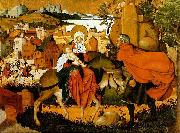 |
Jorg Breu the Elder
|
|
(c. 1475 -- 1537), of Augsburg, was a painter of the German Danube school. He was the son of a weaver.
He journeyed to Austria and created several multi-panel altarpieces there in 1500-02, such as the Melk Altar (1502). He returned to Augsburg in 1502 where he became a master. He travelled to Italy twice, in ca. 1508 and in 1514/15.
After his death in 1537, his son, Jörg Breu the Younger continued to lead his Augsburg workshop until his own death 10 years later. |
|
 |
Jorg Ratgeb
|
|
German Northern Renaissance Painter, ca.1480-1526 |
|
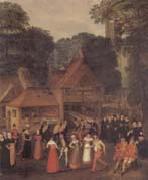 |
joris Hoefnagel
|
|
Flemish Northern Renaissance Manuscript Illuminator, 1542-ca.1600,Flemish illuminator and draughtsman. He was the last of the great Flemish manuscript illuminators and the foremost topographical draughtsman of his age. His work forms a critical link between earlier manuscript illumination and ornamental design and the genre of floral still-life painting, |
|
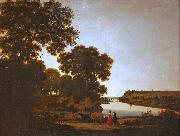 |
Joris van der Haagen
|
|
(ca. 1615 - The Hague, 23 May 1669 (buried)) was a Dutch Golden Age painter specialized in landscapes.
Contents
It is unclear where Joris van der Haagen was born, either in Arnhem or Dordrecht, but archival evidence shows that he started his drawing career in Arnhem. He probably learned to paint from his father, the painter Abraham van der Haagen. When his father died he moved in 1639 to the Hague, where he joined the Guild of St. Luke in 1643. A year later he became honorary citizen of The Hague. In 1656 he was one of the founding members of the Confrerie Pictura, which was located on the Princessegracht in the Hague. The painting he made of the Princessegracht at this time probably shows the original building, which has since been renovated beyond recognition.
|
|
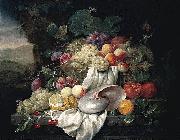 |
Joris van Son
|
|
1623-1667) was a highly popular Flemish Baroque painter of fruit and flowers, in banquet style on a plank, but also in garland form.
He seems to have been influenced by Jan Davidszoon de Heem, since his subjects follow his style quite closely. According to Houbraken his paintings were prized for preserving summer plenty in the middle of winter. In a poem by Cornelis de Bie, it is written that his fruits would tempt a pregnant woman. His paintings hang in many european museums, and the Dutch RKD has over 70 known works by him on record. He signed his works JORIS VAN SON. His students were Frans van Everbroeck, Jan Pauwel Gillemans II, and Norbert Montalie. |
|
|
|
 |
Jose del Castillo
|
|
1737-1793
Spanish
Jose del Castillo Location
a Spanish painter and a leader of the artistic movement Illustrious Absolutism. Many of his paintings were done on tapestries.
Castillo made many attempts to become Royal Painter for the Spanish monarchy, but he was never successful. This was not due to a lack of talent, but rather because Castillo allied himself with the wrong noble. His patron, the Earl of Floridablanca, feuded bitterly with the Earl of Aranda. The Earl of Aranda was favored by King Carlos III, and as a result, Ram??n Bayeu (Aranda favorite painter) became Royal Painter.
After Carlos III died, Castillo tried again to become Royal Painter. Unfortunately, the new monarch, Carlos IV, decided to leave the position of Royal Painter vacant.
|
|
 |
Jose Antolinez
|
|
Spanish Baroque Era Painter, 1635-1675
was a Spanish painter of the Baroque period. Antolinez's early training as a landscape artist may have been under Iriarte. Later, when he moved to the court in Madrid, he entered the studio of Francisco Rizi. His '"haughty character and sarcastic personality gained him many enemies among his contemporaries". Some note he played maddening jokes on his colleagues Claudio Coello and Cabezalero as well as Itizi, whom he called painter of wall ornaments, in allusion to the latter's decoration of the hall of comedies in the Palace of Buen Retiro |
|
|
|
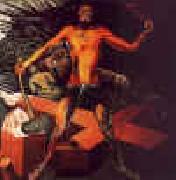 |
Jose Clemente Orozco
|
|
Mexican
1883-1949
Jose Clemente Orozco Gallery
Jose Clemente Orozco (November 23, 1883 ?C September 7, 1949) was a Mexican social realist painter, who specialized in bold murals that established the Mexican Mural Renaissance together with murals by Diego Rivera, David Siqueiros, and others. Orozco was the most complex of the Mexican muralists, fond of the theme of human suffering, but less realistic and more fascinated by machines than Rivera. Mostly influenced by Symbolism, he was also a genre painter and lithographer. Between 1922 and 1948, Orozco painted murals in Mexico City, Orizaba, Claremont, California, New York City, Hanover, New Hampshire, Guadalajara, Jalisco, and Jiquilpan, Michoac??n. His drawings and paintings are exhibited by the Carrillo Gil Museum in Mexico City, and the Orozco Workshop-Museum in Guadalajara.
Jos?? Clemente Orozco was born in Zapotl??n el Grande (now Ciudad Guzm??n), Jalisco to Rosa de Flores Orozco. He married Margarita Valladares, and had three children. In a childhood accident, Orozco lost his left hand while playing with gunpowder.
Jos?? Guadalupe Posada, a satirical illustrator whose engravings about Mexican culture and politics challenged Mexicans to think differently about post-revolutionary Mexico, worked in full view of the public in shop windows located on the way Orozco went to school. In his autobiography, Orozco confesses, "I would stop [on my way to and from school] and spend a few enchanted minutes in watching [Posada]?? This was the push that first set my imagination in motion and impelled me to cover paper with my earliest little figures; this was my awakening to the existence of the art of painting." (Orozco, 1962) He goes to say that watching Posado's engraving decorated gave him his introduction to the use of color. After attending school for Agriculture and Architecture, Orozco studied art at the San Carlos Academy.
With Diego Rivera, he was a leader of the artist movement known as Mexican Muralism. An important distinction he had from Rivera was his critical view of the Mexican Revolution. While Diego was a bold, optimistic figure, touting the glory of the revolution, Orozco was less comfortable with the bloody toll the social movement was taking. Orozco is known as one of the "Big Three" muralists along with Diego Rivera and David Alfaro Siqueiros. All three artists, as well as the painter Rufino Tamayo, experimented with fresco on large walls, and elevated the art of the mural. |
|
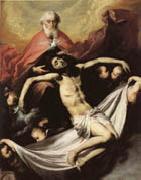 |
Jose de Ribera
|
|
Spanish Painter and Print engraver , 1591-1652
Information concerning the life and personality of Jusepe de Ribera is sparse. He was born the son of a shoemaker in Jetiva, Valencia Province. He appears to have gone to the city of Valencia while still a boy, but nothing is known of his possible artistic training there. As an adolescent, he traveled to Italy and spent time in Lombardy. Next he was in Parma, from which, it is said, he was driven by the contentious jealousy of local artists. He located himself in Rome until an accumulation of debts forced him to flee. Finally he settled in Naples, where in 1616 he married Caterina Azzolino, the daughter of a painter, by whom he had seven children between the years 1627 and 1636. The Academy of St. Luke in Rome elected Ribera to membership in 1625, and 6 years later the Pope conferred upon him the Order of Christ. It is understandably speculated that Ribera revisited Rome for these events. Being sought after in Naples by the Church and the various Spanish viceroys who ruled there in the name of the Spanish monarchy, he dismissed the idea of returning to his homeland. He was quoted as saying that he was honored and well paid in Naples and that Spain was a cruel stepmother to its own children and a compassionate mother to foreigners. Nevertheless, he generally added his nationality when he signed his works. This practice inspired the Italians to nickname him "the Little Spaniard" (Lo Spagnoletto). The last decade of Ribera's life was one of personal struggle. He suffered from failing health, the taunts of other artists that his fame was "extinct," and difficulty in collecting payments due him. Nevertheless, he kept it from being a tragic defeat by continuing to paint until the very year of his death in Naples. Actually, he was the victim of the local politics and finances. Naples was in the throes of a severe economic depression for which the foreign rulers, the patrons of Ribera, were naturally blamed, and the desperate citizenry was rioting in the streets. It is significant that Ribera continued to receive commissions in such a time, even if there was a dearth of payments. Ribera was inventive in subject matter, ranging through visionary spectacles, biblical themes, genre, portraits, mythological subjects, and portraits of ascetics and penitents. |
|
 |
Jose Ferraz de Almeida Junior
|
|
(8 May 1850 - 13 November 1899) was a Brazilian painter of the 19th century. He is widely regarded as the most important Brazilian realist painter of the 19th century, and a major inspiration for the modernist painters. While most Brazilian academic artists made their fame painting mythological or historical subjects, Almeida Junior would become popular for painting rural figures, especially farmers and the caipira violeiro , the countrymen that are a kind of a symbol of the rural areas of the São Paulo state.
While most realist painters used farmers and countrymen as an allegory of workers, Almeida Junior would paint his caipiras mostly on leisure time. He would also produce touching images of upscale landowners. The Bandeirantes, the ruthless explorers of colonial Brazil, would be depicted in the A partida da monção, showing an expedition on the Tiete River.
Almeida Junior was born in the city of Itu, then a small town in the state of São Paulo. After becoming a sensation in his town he would be invited to study in the Brazilian Imperial Fine Arts Academy of Rio de Janeiro, but in 1876 would study in France after being granted a scholarship by emperor Pedro II of Brazil in person in the city of Moji-Mirim. He would have Alexandre Cabanel as one of his masters. In 1877 he was already enrolled in the School of Fine Arts in Paris. He took part at the Salon de Paris with several works of art in 1879 (Retrato do Dr. Jose de Magalhães), 1880 (O Derrubador Brasileiro) and (Remorso de Judas), 1881 (Fuga para o Egito) and 1882 (Descanso do Modelo) He admired the French realist and naturalist painting (a major influence at his work), and, after returning to Brazil in 1882, became of the leading names in Brazilian realist painting.
He was stabbed to death by the husband of his mistress on November 13, 1899 in Piracicaba.
|
|
|
|
|
|
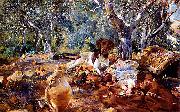 |
Jose Jimenez Aranda
|
|
(February 7, 1837 - May 6, 1903) was a Spanish painter.
Persondata
Name Jimenez Aranda, Jose
Alternative names
Short description
Date of birth February 7, 1837
Place of birth
Date of death May 6, 1903
Place of death
|
|
|
|
|
|
 |
Jose Legarda
|
|
painted Portrait of Manuel de Alday, bishop of Santiago de Chile in 1772 |
|
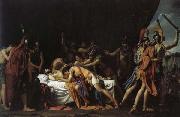 |
jose Madrazo Y Agudo
|
|
Spanish Neoclassical Painter, 1781-1859
was a Spanish painter of the Neoclassic period. Born in Santander. Studied in Madrid with Cosme de Acuna and Gregorio Ferro, both rectors of the Academia de San Fernando at the beginning of the 19th century. Don Fernando La Serna, who was named ambassador to France at the time, brought Madrazo to Paris, where he entered the studio of Jacques-Louis David. There, under royal patronage from King Carlos IV, he executed a painting of the Death of Lucretia and other canvases on events from classic Greco-Roman history. He moved to Rome during Napoleonic times, where he was briefly jailed for failing to complete oaths of loyalty to the newly installed Napoleon II of France as King of Rome. In Rome, he was admitted to the Accademia di San Luca. King Carlos IV named him pintor de camara (painter of the chamber), a position confirmed by King Ferdinand VII. |
|
 |
Jose Malhoa
|
|
(Caldas da Rainha, 28 April 1855 ; Figueire dos Vinhos, 26 October 1933) was a Portuguese painter.
Malhoa was, with Columbano Bordalo Pinheiro, the leading name in Portuguese naturalist painting, in the second half of the 19th century. He painted often popular scenes and subjects, like his two most famous paintings, "The Drunks" (1907) and "Fado" (1910). He always remained faithful to the naturalist style, but in some of is works, there are impressionist influences, like in his "Autumn" (1918), that can be considered as an "impressionist exercise".
He saw at the end of his life, the inauguration of the Jose Malhoa Museum, in Caldas da Rainha.
|
|
|
|
|
|
|
|
|
|
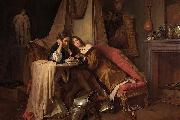 |
Josef Danhauser
|
|
Josef Danhauser (August 19, 1805, Laimgrube (now a part of Mariahilf or Neubau) - May 4, 1845) was an Austrian painter, one of the main artists of Biedermeier period, together with Ferdinand Georg Waldmeller, Peter Fendi, among others. His works, not very appreciated in his days, dealt with very moralising subjects and they had a clear influence of William Hogarth.
Joseph Danhauser was born in Vienna in 1805, the eldest son of sculptor and furniture manufacturer Joseph Ulrich Danhauser and his wife Johanna (nee Lambert).
He took his first painting lessons with his father and he later assisted the Vienna Academy of Fine Arts. He studied with Johann Peter Krafft and made his first exhibition 1826.
Invited by Johann Ladislaus Pyrker, patriarch of Venice, he visited the city of Doges, where he started to study the Italian masters. He came back to Vienna via Trieste in 1827, visiting Prague. That very year he painted Ludwig van Beethoven's death mask, roughly 12 hours after his death and a water-colour representing his deathbed. In 1828, he spent some time in Eger, with an invitation of this Hungarian city archbishop Pyrker. He solicited him for some pictures for the gallery of the Archdiocese.
After his father's death in 1829, his brothers and he managed his furniture factory during the Biedermeier movement, being the precursors of modern design. That made him put his painting career aside.
In 1833, he responded to a second invitation from Eger's archbishop and he painted The martyr of Saint John for a new basilica in the city and he received the Vienna Academy prize for his picture Die Verstobung der Hagar and he specialised in Genre works. In 1838, he was appointed vice-rector of the Academy and married Josephine Streit, who was the daughter of a physician and with whom he had three children, Josef, Marie and Julie, born in 1839, 1841 and 1843 respectively.
Josef Danhauser was appointed professor of historical Painting at the Academy in 1841, but he left this occupation and he travelled around Germany and the Netherlands with the textile maker, art aficionado and art sponsor Rudolf von Arthaber. In this journey, he was very interested in the Dutch School and the format of his works was littler. He died of typhus in Vienna in 1845. They named a street with his name in Vienna in 1862. |
|
|
|
|
|
|

